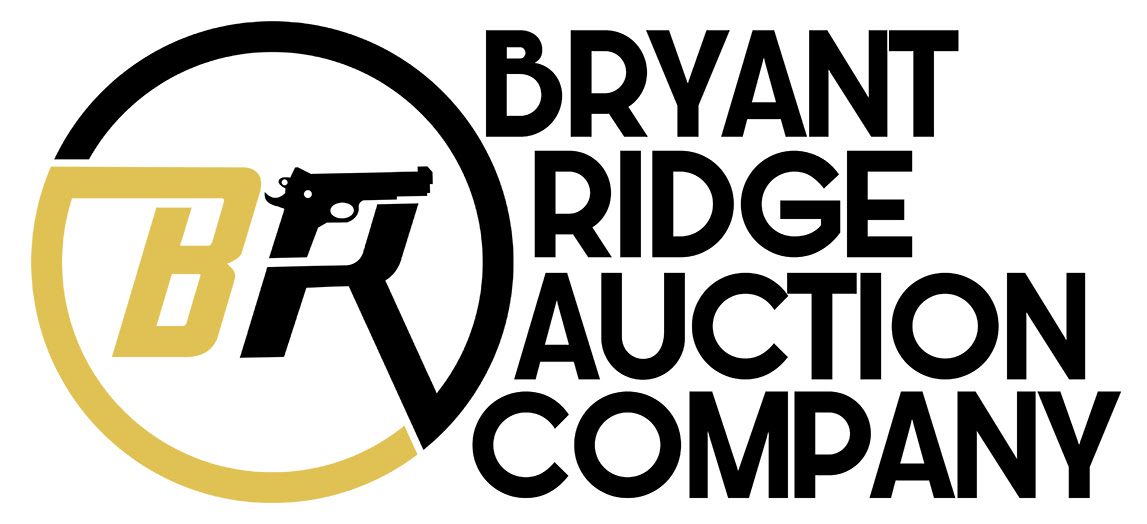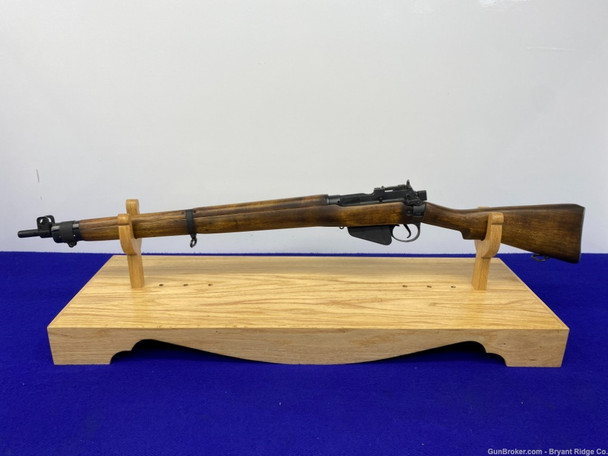Description

Item Description
Bryant Ridge Auction Company is pleased to present this incredible bolt-action rifle today for a penny start auction, this is the British No.4 MKI!
Click here to view our other Live Auctions!
Click here to view our other Live Auctions!
SPECIFICATIONS:
Manufacturer: British
Model: No.4 MKI
Serial: 15828
Date of Manufacture: 1942
Caliber: .303 British
Finish: Blue
Barrel Length: 25"
Optics/Sights: Winged protected blade front with Fold adjustable aperture rear
Stock/Grips: Smooth wood stock
Action: Bolt-Action
Markings: Standard / Left side plate above the trigger is stamped "1942 AD 15828". The magazine features a matching serial number.
Bryant Ridge's Analysis:
By the late 1930s, the need for new rifles grew, and the Rifle, No. 4 Mk I was officially adopted in 1941. The No. 4 action was similar to the No.1 Mk VI but stronger and easier to mass-produce. Unlike the SMLE, which had a nose cap, the No 4 Lee–Enfield barrel protruded from the end of the forestock. For easier machining, the charger bridge was no longer rounded. The iron sight line was redesigned and featured a rear receiver aperture battle sight calibrated for 300 yd (274 m) with an additional ladder aperture sight that could be flipped up and was calibrated for 200–1,300 yd (183–1,189 m) in 100 yds (91 m) increments. This sight, like other aperture sights, proved to be faster and more accurate than the typical mid-barrel open rear sight elements sight lines offered by Mauser, previous Enfields, or the Buffington battle sight of the M1903 Springfield.
The No. 4 rifle was heavier than the No. 1 Mk. III, largely due to its heavier barrel. A new bayonet was designed to go with the rifle: a spike bayonet, the No. 4 bayonet, essentially a steel rod with a sharp point, nicknamed "pigsticker" by soldiers. Towards the end of the Second World War, a bladed bayonet was developed for the No.5 Mk.I rifle ("jungle carbine"). Post-war versions were made that would fit No. 4 rifles and were designated No. 7 and No. 9 blade bayonets.
During the course of the Second World War, the No. 4 rifle was further simplified for mass production with the creation of the No. 4 Mk I* in 1942, with the bolt release catch replaced by a simpler notch on the bolt track of the rifle's receiver. It was produced only by Small Arms Limited at Long Branch in Canada and Stevens-Savage Firearms in the US. The No.4 rifle was primarily produced for the United Kingdom, Canada, and some other Commonwealth countries, including New Zealand. In 1943, it cost £7 15s (£7.75) to produce. By comparison, a Sten Mk II submachine gun cost £2 10s (£2.50).
Return Policy:
We gladly offer a 3 day unfired inspection policy from the time that the firearm is delivered to your FFL. Refunds are available for all qualifying orders.
Model: No.4 MKI
Serial: 15828
Date of Manufacture: 1942
Caliber: .303 British
Finish: Blue
Barrel Length: 25"
Optics/Sights: Winged protected blade front with Fold adjustable aperture rear
Stock/Grips: Smooth wood stock
Action: Bolt-Action
Markings: Standard / Left side plate above the trigger is stamped "1942 AD 15828". The magazine features a matching serial number.
Bryant Ridge's Analysis:
By the late 1930s, the need for new rifles grew, and the Rifle, No. 4 Mk I was officially adopted in 1941. The No. 4 action was similar to the No.1 Mk VI but stronger and easier to mass-produce. Unlike the SMLE, which had a nose cap, the No 4 Lee–Enfield barrel protruded from the end of the forestock. For easier machining, the charger bridge was no longer rounded. The iron sight line was redesigned and featured a rear receiver aperture battle sight calibrated for 300 yd (274 m) with an additional ladder aperture sight that could be flipped up and was calibrated for 200–1,300 yd (183–1,189 m) in 100 yds (91 m) increments. This sight, like other aperture sights, proved to be faster and more accurate than the typical mid-barrel open rear sight elements sight lines offered by Mauser, previous Enfields, or the Buffington battle sight of the M1903 Springfield.
The No. 4 rifle was heavier than the No. 1 Mk. III, largely due to its heavier barrel. A new bayonet was designed to go with the rifle: a spike bayonet, the No. 4 bayonet, essentially a steel rod with a sharp point, nicknamed "pigsticker" by soldiers. Towards the end of the Second World War, a bladed bayonet was developed for the No.5 Mk.I rifle ("jungle carbine"). Post-war versions were made that would fit No. 4 rifles and were designated No. 7 and No. 9 blade bayonets.
During the course of the Second World War, the No. 4 rifle was further simplified for mass production with the creation of the No. 4 Mk I* in 1942, with the bolt release catch replaced by a simpler notch on the bolt track of the rifle's receiver. It was produced only by Small Arms Limited at Long Branch in Canada and Stevens-Savage Firearms in the US. The No.4 rifle was primarily produced for the United Kingdom, Canada, and some other Commonwealth countries, including New Zealand. In 1943, it cost £7 15s (£7.75) to produce. By comparison, a Sten Mk II submachine gun cost £2 10s (£2.50).
Return Policy:
We gladly offer a 3 day unfired inspection policy from the time that the firearm is delivered to your FFL. Refunds are available for all qualifying orders.
Shipping Details
Handgun Standard Shipping $50.00
Long Gun Standard Shipping $70.00
Any orders placed with magazines that are not compliant with your state, county, or city regulations will not ship with your order.
















